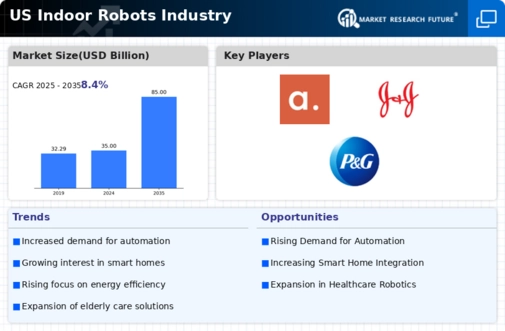Consumer Awareness and Acceptance
Consumer awareness and acceptance of indoor robots are crucial drivers for the market's growth. As technology becomes more integrated into daily life, consumers are increasingly recognizing the benefits of indoor robots for enhancing convenience and efficiency. Educational campaigns and demonstrations have played a significant role in dispelling misconceptions about robotics, leading to a more favorable perception. The indoor robots market is witnessing a shift in consumer attitudes, with more individuals willing to invest in robotic solutions for their homes. This growing acceptance is expected to contribute to a steady increase in market penetration, with projections indicating a rise in household robot ownership by 25% over the next five years.
Growing Demand for Home Automation
The indoor robots market is significantly influenced by the growing demand for home automation solutions. As consumers increasingly seek convenience and efficiency in their daily lives, the adoption of indoor robots for tasks such as cleaning, security, and monitoring is on the rise. According to recent data, the home automation market is expected to reach $80 billion by 2026, with a substantial portion attributed to indoor robots. This trend indicates a shift in consumer preferences towards smart home technologies, which enhances the appeal of the indoor robots market. Consequently, manufacturers are focusing on developing robots that integrate seamlessly with existing home automation systems.
Increased Focus on Health and Hygiene
The indoor robots market is benefiting from an increased focus on health and hygiene, particularly in residential and commercial spaces. The demand for robots capable of sanitizing and disinfecting environments has surged, as consumers and businesses prioritize cleanliness. For example, robots equipped with UV-C light technology are being deployed in various settings to eliminate pathogens effectively. This trend is likely to drive growth in the indoor robots market, as the emphasis on maintaining hygienic spaces becomes a standard expectation. Market analysts predict that the segment for cleaning and disinfecting robots will account for over 30% of total sales in the coming years.
Technological Advancements in Robotics
The indoor robots market is experiencing a surge due to rapid technological advancements in robotics. Innovations in artificial intelligence, machine learning, and sensor technologies are enhancing the capabilities of indoor robots. These advancements allow robots to perform complex tasks with greater efficiency and accuracy. For instance, the integration of advanced navigation systems enables robots to map and navigate indoor environments seamlessly. As a result, the market is projected to grow at a CAGR of approximately 15% over the next five years, driven by the increasing demand for automation in households and businesses. The indoor robots market is thus poised for significant expansion as these technologies continue to evolve.
Rising Labor Costs and Workforce Shortages
The indoor robots market is also being propelled by rising labor costs and workforce shortages across various sectors. As businesses face challenges in hiring and retaining staff, particularly in service-oriented industries, the adoption of indoor robots is seen as a viable solution. These robots can perform repetitive tasks, thereby alleviating the burden on human workers and allowing them to focus on more complex responsibilities. The indoor robots market is likely to see increased investment as companies seek to automate processes to counteract labor challenges. This trend may lead to a projected market growth of 20% in the next few years.













Leave a Comment